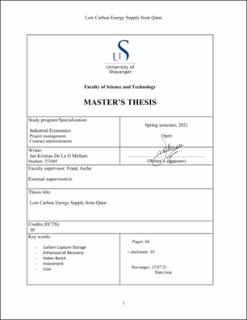| dc.contributor.advisor | Ache, Frank | |
| dc.contributor.author | Mellum, Jan Kristian Mellum | |
| dc.date.accessioned | 2021-11-11T16:51:16Z | |
| dc.date.available | 2021-11-11T16:51:16Z | |
| dc.date.issued | 2021 | |
| dc.identifier | no.uis:inspera:78874059:10819759 | |
| dc.identifier.uri | https://hdl.handle.net/11250/2829202 | |
| dc.description.abstract | In the recent decades the focus towards renewable energy sources has increased drastically. The global energy consumption is increasing each year, but we are consuming more than we can sustain. Associated with the increase of energy consumption is the increase of greenhouse gases, which further leads to global warming. Most of the energy comes from fossil fuels, but these energy sources are limited and are harming the environment. In the global energy transition the world needs to gradually transition towards environmentally friendly solution and that is what the low-carbon energy from Qatar will do.
The low-carbon energy supply complex will be in Ras Laffan, Qatar, because of the large access to raw materials such as natural gas and water, a harbour for shipping, and reservoirs that can store large amounts of CO2. The complex will be self-sustainable meaning that the natural gas will be provided from the North Dome and the electricity will be provided from powerplant on location. The project addresses the use of about 70% of the annual gas production towards the production of ammonia and the remaining 30% goes to other petrochemical products or export.
The project will address technical solutions, supply chain and the investment scenario related to the establishment of a comprehensive low-carbon energy supply from Qatar. The production of ammonia in this complex is estimated, revealing that the cost per ton of ammonia can be estimated as low as 247,90 USD/ton Ammonia without the shipping cost or as high as 418,326 USD/ton ammonia. Compared to the average price of 320 USD/ton ammonia in 2021 it is very much plausible to implement this project and create competitive prices against other renewable recourses.
The ammonia produced is environmentally friendly, but this comes at the cost in the form a reduction of energy that could have potentially come from the natural gas, this is the price to pay for low-carbon energy. For ammonia to reach the same energy output as natural gas, the amount of ammonia needed is 2,44 times larger compared to natural gas. For ammonia to be competitive in price a global CO2 tax ranging from around 250 – 300 USD/ton CO2 must be implemented. | |
| dc.description.abstract | In the recent decades the focus towards renewable energy sources has increased drastically. The global energy consumption is increasing each year, but we are consuming more than we can sustain. Associated with the increase of energy consumption is the increase of greenhouse gases, which further leads to global warming. Most of the energy comes from fossil fuels, but these energy sources are limited and are harming the environment. In the global energy transition the world needs to gradually transition towards environmentally friendly solution and that is what the low-carbon energy from Qatar will do.
The low-carbon energy supply complex will be in Ras Laffan, Qatar, because of the large access to raw materials such as natural gas and water, a harbour for shipping, and reservoirs that can store large amounts of CO2. The complex will be self-sustainable meaning that the natural gas will be provided from the North Dome and the electricity will be provided from powerplant on location. The project addresses the use of about 70% of the annual gas production towards the production of ammonia and the remaining 30% goes to other petrochemical products or export.
The project will address technical solutions, supply chain and the investment scenario related to the establishment of a comprehensive low-carbon energy supply from Qatar. The production of ammonia in this complex is estimated, revealing that the cost per ton of ammonia can be estimated as low as 247,90 USD/ton Ammonia without the shipping cost or as high as 418,326 USD/ton ammonia. Compared to the average price of 320 USD/ton ammonia in 2021 it is very much plausible to implement this project and create competitive prices against other renewable recourses.
The ammonia produced is environmentally friendly, but this comes at the cost in the form a reduction of energy that could have potentially come from the natural gas, this is the price to pay for low-carbon energy. For ammonia to reach the same energy output as natural gas, the amount of ammonia needed is 2,44 times larger compared to natural gas. For ammonia to be competitive in price a global CO2 tax ranging from around 250 – 300 USD/ton CO2 must be implemented. | |
| dc.language | eng | |
| dc.publisher | uis | |
| dc.title | Lavkarbon energiforsyning fra Qatar | |
| dc.type | Master thesis | |
